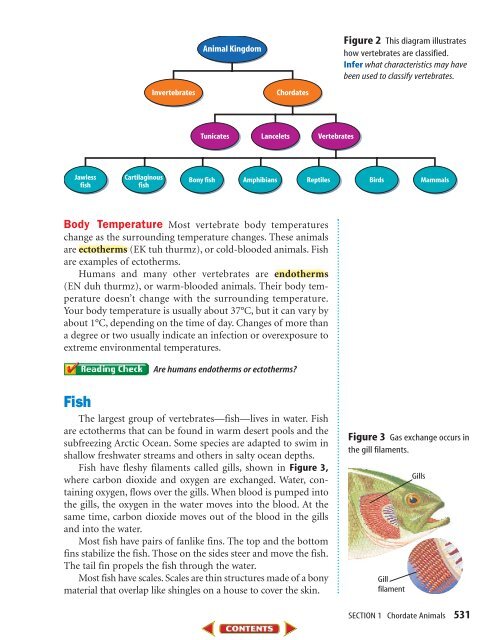Chapter 18: Vertebrate Animals
Chapter 18: Vertebrate Animals
Chapter 18: Vertebrate Animals
You also want an ePaper? Increase the reach of your titles
YUMPU automatically turns print PDFs into web optimized ePapers that Google loves.
Animal Kingdom<br />
Figure 2 This diagram illustrates<br />
how vertebrates are classified.<br />
Infer what characteristics may have<br />
been used to classify vertebrates.<br />
Invertebrates<br />
Chordates<br />
Tunicates Lancelets <strong>Vertebrate</strong>s<br />
Jawless<br />
fish<br />
Cartilaginous<br />
fish<br />
Bony fish Amphibians Reptiles Birds Mammals<br />
Body Temperature Most vertebrate body temperatures<br />
change as the surrounding temperature changes. These animals<br />
are ectotherms (EK tuh thurmz), or cold-blooded animals. Fish<br />
are examples of ectotherms.<br />
Humans and many other vertebrates are endotherms<br />
(EN duh thurmz), or warm-blooded animals. Their body temperature<br />
doesn’t change with the surrounding temperature.<br />
Your body temperature is usually about 37°C, but it can vary by<br />
about 1°C, depending on the time of day. Changes of more than<br />
a degree or two usually indicate an infection or overexposure to<br />
extreme environmental temperatures.<br />
Are humans endotherms or ectotherms<br />
Fish<br />
The largest group of vertebrates—fish—lives in water. Fish<br />
are ectotherms that can be found in warm desert pools and the<br />
subfreezing Arctic Ocean. Some species are adapted to swim in<br />
shallow freshwater streams and others in salty ocean depths.<br />
Fish have fleshy filaments called gills, shown in Figure 3,<br />
where carbon dioxide and oxygen are exchanged. Water, containing<br />
oxygen, flows over the gills. When blood is pumped into<br />
the gills, the oxygen in the water moves into the blood. At the<br />
same time, carbon dioxide moves out of the blood in the gills<br />
and into the water.<br />
Most fish have pairs of fanlike fins. The top and the bottom<br />
fins stabilize the fish. Those on the sides steer and move the fish.<br />
The tail fin propels the fish through the water.<br />
Most fish have scales. Scales are thin structures made of a bony<br />
material that overlap like shingles on a house to cover the skin.<br />
Figure 3 Gas exchange occurs in<br />
the gill filaments.<br />
Gill<br />
filament<br />
Gills<br />
SECTION 1 Chordate <strong>Animals</strong> 531

















